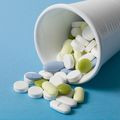 To conquer disease a lot of work is put into developing better medicines and surgical operations, as well as making vaccines and finding other ways of preventing diseases. Much of this work is for human medicine; some is to treat diseases suffered by both humans and animals, and some is specially for animal medicine.
To conquer disease a lot of work is put into developing better medicines and surgical operations, as well as making vaccines and finding other ways of preventing diseases. Much of this work is for human medicine; some is to treat diseases suffered by both humans and animals, and some is specially for animal medicine.
The development of polio and diphtheria vaccines, insulin for diabetes, and kidney transplants are all examples of medical advances that depended on animal research. This sort of research will be needed for the new medicines and other treatments of the future. There are many diseases that we cannot yet cure, such as multiple sclerosis and certain cancers, as well as new diseases like AIDS; and in many cases animal research is playing an important part in the search for cures.
As this is a relatively large area of research and testing it is useful to split it into three main areas. Animals are vital in all three.
- basic research to find new vaccines and treatments
- applied research developing new medicines and vaccines and improving existing ones
- regulatory testing potential new medicines to make sure they are effective and safe
The last of these, safety testing, is carried out only after the potential medicine has come through many tests on isolated cells and tissues. Safety testing accounts for less than half of animals in this category, or 7% of animals used in all medical research. Safety testing is vitally important - and it's a legal requirement - before tests on human volunteers and patients in clinical trials. A new medicine is usually tested on more humans than animals before it is allowed to be prescribed by doctors.
Applied research accounts for just under 10% of all animal procedures carried out in the UK. Click here for more information on numbers of animals used in the UK, including the latest statistics.
IMAGE©ISTOCKPHOTO.COM/KUTAYTANIR



